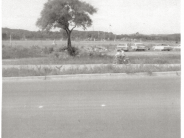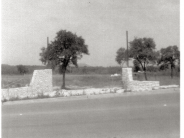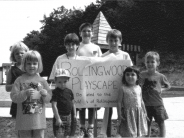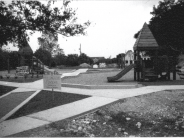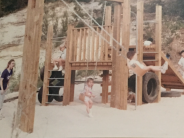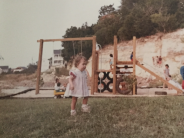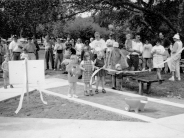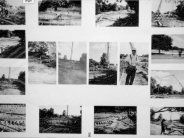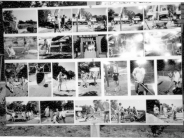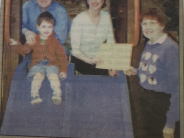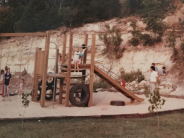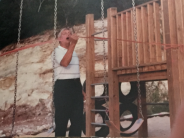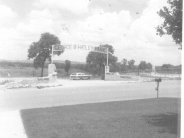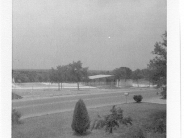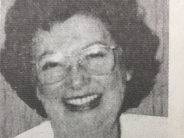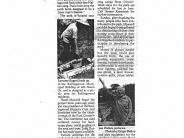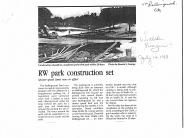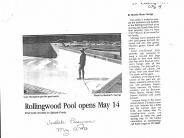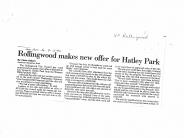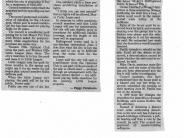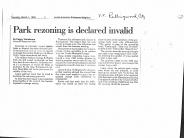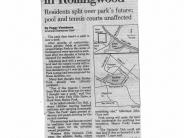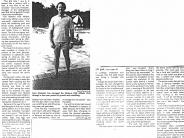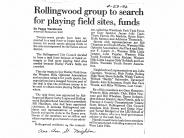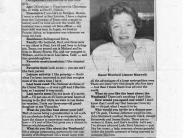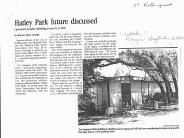History of Rollingwood Park
Rollingwood has lovely parks. From the early days there was talk of creating a park for children in
the city. Through the years the park has received mixed reception. Some residents have disliked the
crowds it created, some objected to the cutting of curbs and erection of George B. Hatley gate. Others
in the community have viewed the park as an asset to the city. Before the development of Hatley Park in 1968, sporting events were conducted on acreage owned by Austin Independent School district on the corner of Ridgewood and Rollingwood Drive.
1950s
Rollingwood park land was owned by the Western Hills Optimist Club, a non-profit corporation founded in 1955 by A.A. Mack Hull with twenty charter members, many of whom lived in Rollingwood. The club purchased, from George B. Hatley, eleven acres of land bordered by Rollingwood Drive, Nixon, Gentry, Wallis and Pleasant Drive. The primary purpose of the club was to encourage development of youth.
1968
While the land was being cleared and developed by club members the little league football, baseball and girls softball teams were being formed. Tons of dirt was trucked over from the expansion of Bee Caves road to level the fields, which were once hills. The Optimist Club eventually added restrooms and a concession stand.
1970
The Western Hills Athletic Club organized and acquired several acres in the corner of the park, at Rolligwood and Wallace, where it built a private swimming pool and tennis courts. The City of Rollingwood purchased 1.0009 acres on Nixon Drive from the Optimist Club of Western Hills. This is the land the City Hall was built upon in 1975 for the future municipal building, which was built in 1975.
1978
The Rollingwood Park Project was the brain child of resident, Hazel Maxwell and was sponsored by the City Council and Rollingwood Woman’s Club (RWC). Hazel started the project with contributions of $750 from the city and $270 from the Rollingwood Women’s club. In 1978, $350 was used to pay Bud Twilley, a landscape architect to draw plans for the lower park. The park was to include 7 picnic areas and “earth berms” (grassy hills) similar to that of Wooldridge Park, which is an urban park in downtown Austin that has a natural basin whose sides slope inward to form an amphitheater with a bandstand at its center.
1979
Donations from firemen and the Women’s Club paid for stacking boulders along Nixon Lane. Members raised funds for the park by recycling aluminum cans, organizing a Sampler Supper with residents bringing a casserole or covered dish and 10 copies of recipes that were sold for .25 cents each. At that event the club made over $50 in contributions and sale of recipes. All money went to the park fund.
1980
The land was graded, a berm built, 35 fledgling trees planted, a raised knoll to be used for performances was built and a sprinkler system was installed. The only native tree in the Rollingwood Park was a forty-foot Cottonwood. The park grew a tree at a time and a fence post at a time.
1982
Fund raising efforts were underway to pay for 3 Live Oak Trees, Pampas Grass, seven picnic tables and playground equipment. Hundreds of people gave time, materials and money in order to continue the progress.
1983-1984
Representatives of the city of Rollingwood, the Optimist Club and the Western Hills Youth Association discuss forming a structure to insure that Hatley Park in Rollingwood always remains as a park for organized athletic activities. At his own expense, resident and former Mayor, Corky Logue knocked down the dilapidated Optimists building.
1985
In June a new playscape was installed at a cost of $2,200 in the lower park area. It was actually on 35 feet of land donated by the Optimist Club because the Rollingwood Park committee did not want to alter the original park plans, which did not include play equipment. Money for the playscape came from a garage sale organized by the Babysitting Cooperative ($273), a donation from the Women’s Club ($500), the Halloween Bandit’s Cave ($105) and individual contributions ($1,206). The old Optimist building was bulldozed because it was unsightly and unsafe.
1986
More than 650 youth used the baseball fields, 550 participated in soccer, 140 played girls softball and 70 participated in football. In 1986 the Optimists offered the property to Eanes School district but no action was taken.
1990
In January 1990, the City Council voted to rezone the athletic fields in Rollingwood Park from residential to park. The 3-1 vote was declared invalid in March after discovering a super majority was needed to change the zoning. After the invalid vote, the City Council re-initiated the zoning process and voted to rezone the fields, changing from residential to parkland use.
Tax collectors sued the Optimist Club for $64,242 in taxes, penalties and interest for two years when the club failed to reapply for a tax exemption. A 27-member task force was formed with Rollingwood, surrounding communities and Eanes ISD. Rollingwood set a hearing for purchase of Hatley Park using a settlement for overcharges in water rate. Several people disputed using the settlement to buy the park.
June 2, 1990, Rollingwood residents voted 192-107 in a non-binding referendum to approve the city purchase of Hatley Park from the Optimist Club with $200,000 from a water rate settlement with Austin and additional amount from the water fund.
1992
The City of Rollingwood unanimously voted to make an offer to purchase the park land from Western Hills Optimist Club for $220,000 stipulating the club use the money to pay off outstanding taxes of $70,000 and allowed the club to keep one acre on Pleasant Cove to sell, with the City getting first right of refusal.
1993
The Optimist Club of Western Hills sold the 8.934 acres of parkland to the City of Rollingwood, for $245,000. The park was purchased by the City for the recreational benefit and use of residents and property owners in the City and the general public. The warranty deed restrictions were negotiated to ensure the athletic fields would be preserved and prioritized for youth primarily in the Eanes district.
1997
The basic playscapes and surrounding sidewalks in the lower park area were substantially completed. The park was open and dedicated to the children of Rollingwood at the annual Octoberque, which had been an annual community gathering and fund raiser for the volunteer fire department, started more than 30 years before.
2000
The Rollingwood Women’s Club, spearheaded by residents, Marilyn Kounnas, Sandra Farrell and Deb Celusniak and the generous support of the Rollingwood community, raised over $45,000 to purchase a quality playscape and play equipment for the lower park that many children will enjoy for years to come.
2001
The new playground equipment was installed and the old equipment was moved to the upper park playground area.
2005
The 770 sq. foot covered Park Pavilion, designed by Rollingwood Resident and architect, Duke Garwood and was built in the lower park. The Pavilion is designed to hold 4-5 picnic tables and has a capacity of approximately 25 people. The purpose of the pavilion is to provide a shaded area for parents and children using the playscape, and a covered area for neighborhood events such as the Easter Egg Hunt, 4th of July and children’s birthday parties. The Pavilion was paid for using RCDC budgeted sales tax funds at a construction cost of approximately $83,000
2007
The Upper Park Field House was built at a cost of approximately $138,000. The stone, roof and machinery for demolition was donated. Money for the field house was raised through donations and through the sale of park pavers. Frosty Moore whose father was part of the Optimist Club that sold the land to Rollingwood, donated $75,000 in a fund from the Optimist sale, in exchange for naming the field house the Doyle Moore Field House.
2008
The Upper Parking lot was built at a cost of approximately $208,000. The parking lot was a dirt
field where people informally park. The old Optimist building had been located there but was demolished
in the 1980s because it was unsightly and unsafe. The Park Commission was asked by the City
Council to find a solution to the safety concerns of parking around and near the park. This request was
made after many citizens voiced their complaints about safety in this area. Much time was spent on the
design of this lot, as well as providing adequate landscaping and a sidewalk to ensure safe passage to
and from the park. The City Engineer proposed 3 alternatives for this project in the Fall of 2007 for
Park Commission and Council consideration. The Park Commission recommended one solution to
the city and additional funds were approved for the project. In July 2008, the sitting Council unanimously
approved the parking project and the remaining funding.
2010
A walking trail was added to Rollingwood Park. The track surrounds the upper fields and winds down and around the lower park. The walking trail was engineered by Bleyl and Associates and built by the City of Rollingwood Public Works Department with the help of many volunteers. The cost was approximately $85,000. RCDC contributed $35,000 and an additional $25,000 from the Austin Parks Foundation was used, $10,000 was donated by the Rollingwood Women’s Club, $10,000 from the RGK Foundation and $5,000 was redirected from Endeavor tract park development. The little league fence was moved about 10 feet to allow adequate room for the walking trail, at a cost of approximately $6,500. The Rollingwood Community Education Garden was founded by Roni Koltuniak and formed by a group of neighbors who wanted to connect to their community and the soil. This is a communal garden, small in scale but big on ideas about connectivity and sustainability.
2011
Installed for approximately $15,000 were 5 pieces of “Energi Total Body Fitness System” equipment, located in the upper Park on both sides of the playgroup equipment. Nearest to the parking lot are 1) Dynamic Stretches and Active Movement, 2) Angle Bar & Hurdle Exercises. On the other side of the playground equipment are 3) Squats and Dips Exercises 4) Power Step Exercises 5) Stabilizing and Balance Exercises.
2014
The Waterwise garden was designed by Scott Ogden and Lauren Springer Ogden of Plant-Driven Design. The Ogdens collaborated with local designer Patrick Kirwin to create a low-water, no-lawn, deer-resistant garden that offers a beautiful example to neighbors trying to cut back on their own water use. The city received $8,400 in donations solicited through a flier inserted in the monthly water bill plus $8,050 in donations from the Rollingwood Women’s Club. The Women’s Club gave $5,000 for landscaping, $3,000 for a cistern and $50 for a plaque for the cistern.The Endeavor Tract/ Dellana Park was deeded to the City of Rollingwood for use as parkland, in exchange for a tract of land Endeavor needed to connect their proposed new parking structure to their existing buildings. Possible uses are still being considered and the area. This land is not yet part of the Park Commission area of responsibility but may possibly be in the future.
2015
The old playscape in the upper park was deteriorating and was replaced by the City of Rollingwood at a cost of $50,000, paid for with RCDC funds, and installed by We Build Fun, Inc. The Miracle Recreation playground includes a playhouse structure, pirouette spinner, UPC Ant Rock, six spinner and 2 play stations. 8 inches of compacted engineered wood was placed over existing rubber with fabric barrier between materials.
References:
• Eanes: Portrait of a Community. Linda Vance and Dorothy Depwe, 1986 (Taylor Publishing Company)
• Picayune articles from various years
• Information gathered from personal interviews with longtime residents
• Documents and letters provided by longtime residents
Historic Photos and Newspaper Articles
